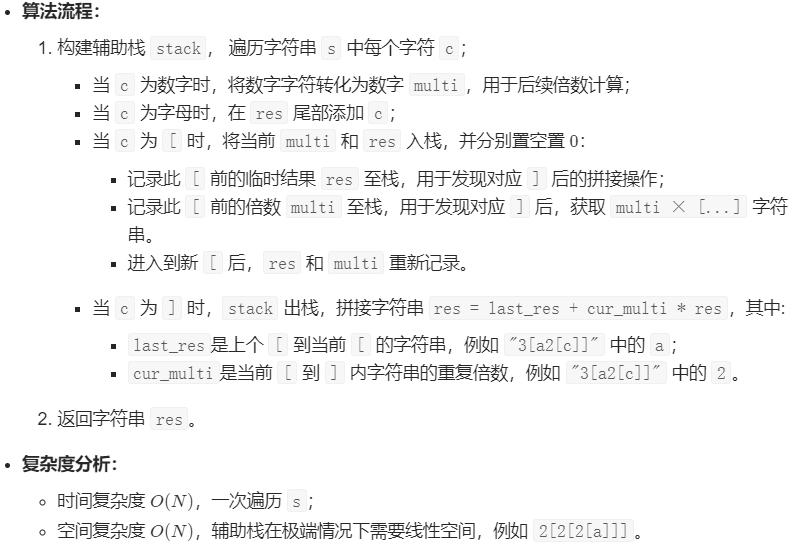本文最后更新于:2022年4月9日 中午
给定一个经过编码的字符串,返回它解码后的字符串。
编码规则为: k[encoded_string],表示其中方括号内部的 encoded_string 正好重复 k 次。注意 k 保证为正整数。
你可以认为输入字符串总是有效的;输入字符串中没有额外的空格,且输入的方括号总是符合格式要求的。
此外,你可以认为原始数据不包含数字,所有的数字只表示重复的次数 k ,例如不会出现像 3a 或 2[4] 的输入。
示例 1:
| 输入:s = "3[a]2[bc]"
输出:"aaabcbc"
|
示例 2:
| 输入:s = "3[a2[c]]"
输出:"accaccacc"
|
示例 3:
| 输入:s = "2[abc]3[cd]ef"
输出:"abcabccdcdcdef"
|
示例 4:
| 输入:s = "abc3[cd]xyz"
输出:"abccdcdcdxyz"
|
Solution
参考:@Krahets 、@九微玄

1
2
3
4
5
6
7
8
9
10
11
12
13
14
15
16
17
18
19
20
21
22
23
24
25
26
27
28
29
30
31
32
| class Solution {
public:
string decodeString(string s) {
stack<pair<int, string>> stack;
int num = 0;
string res = "";
for (int i = 0; i < s.size(); ++i) {
if (s[i] >= '0' && s[i] <= '9') {
num = num * 10 + (s[i] - '0');
}
else if (s[i] == '[') {
stack.push({num, res});
num = 0;
res = "";
}
else if (s[i] == ']') {
int n = stack.top().first;
string tmp = stack.top().second;
stack.pop();
for (int i = 0; i < n; ++i) tmp += res;
res = tmp;
}
else {
res += s[i];
}
}
return res;
}
};
|
